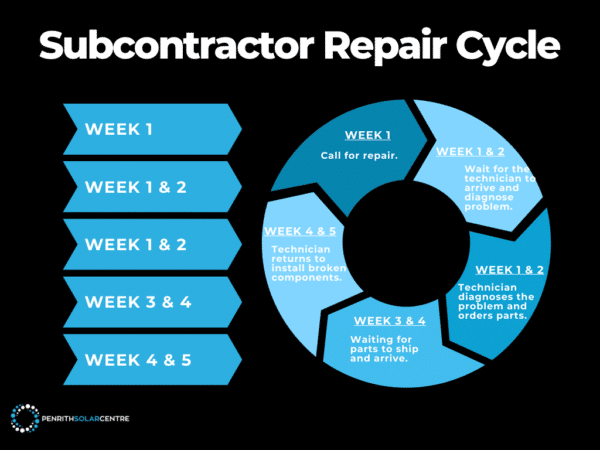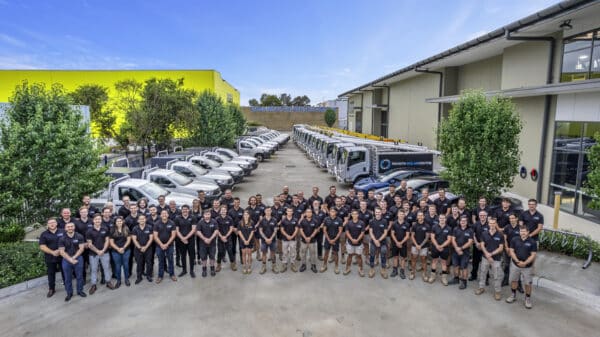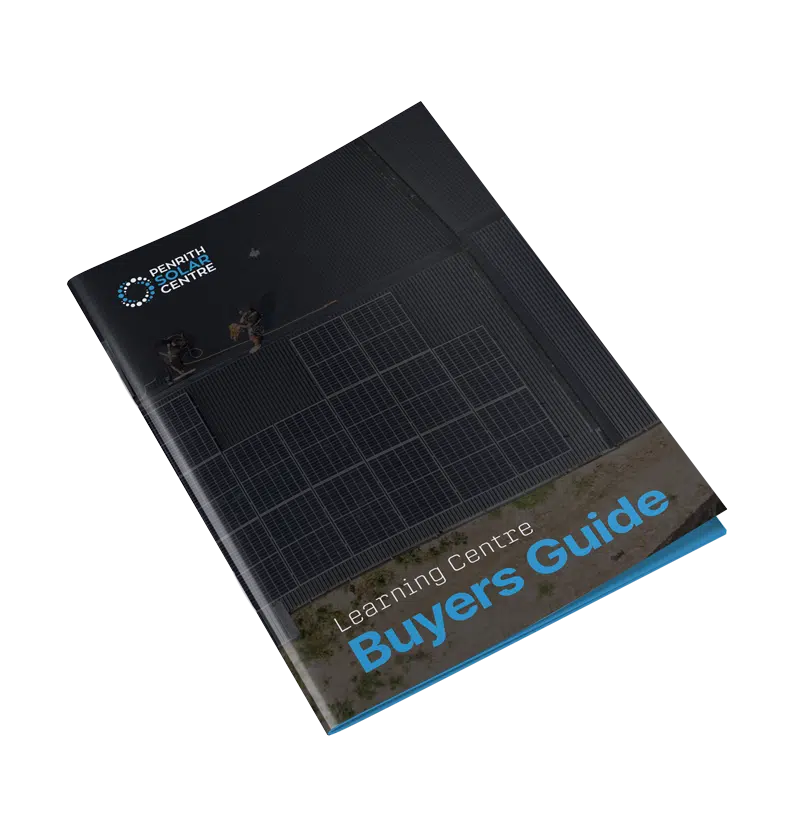
If you’re new to investigating solar energy, you’re probably a little surprised to discover that your choice of an inverter (or microinverter) is more important than the brand of solar panels.
And if you’ve found us, you probably already know that we’re in the microinverter camp in the great debate about which inverter is better. It’s a heated debate, but we’ll be transparent and unbiased here. We promise.
At Penrith Solar Centre, we are well-versed in all kinds of solar technology. We do know a thing or two about how they work. After all, we install Powerwall 3, which is practically a string system. And honestly, some of those string inverters are pretty good quality. In that spirit, we’re pushing forward with a lively bit of writing about how to diagnose and replace inverters (and microinverters).
In this article, you will learn:
- What is a String Inverter?
- Diagnosing Problems with a String Inverter
- Replacing a String Inverter
- Diagnosing Problems with Microinverters
- Replacing a Microinverter
- Comparing Site Visits and Down Time
By the end of this article, you’ll understand how string inverters work and what’s involved in replacing one.
What is a String Inverter?
Your solar panels harvest sunshine and convert it to power in the form of direct current (DC). Direct current is different from alternating current (AC). All the lighting, appliances, and energy to fuel your lifestyle runs on alternating current electricity.
An inverter (or microinverter) is a device that changes DC power from the solar panels into AC power for your home. String inverters are called “string” inverters because they connect a series (a string or an array) of solar panels together.
A string inverter is sometimes called a central inverter because it’s installed in a central location, usually on the side of your home in a shady spot. That’s where it does the work of converting DC power to AC power.
The inverter is a crucial component. If the string inverter fails, your entire solar system stops working. Why is that?
A string inverter system has a central point of failure: the inverter itself on the side of the home. If anything happens to the inverter, the whole system shuts down. This is different from Enphase solar systems with microinverters mounted under each solar panel.
A microinverter is an individual “micro”-inverter. The entire system is decentralised. If one microinverter malfunctions, the whole system just bypasses it and the rest of the panels with microinverters keep producing solar power for your home.
Think of a solar system like the motorway.
Microinverter System: A microinverter system has four lanes of traffic, and each lane has a car of its own. The flow of traffic is decentralised across four lanes.
String Inverter System: It has four cars right behind each other in one lane. If anything happens to the speed of the first car, the other three slow down to match it.
If you’re interested in learning a bit more about how microinverters compare to string inverters, you might want to check out the following article titled, Microinverters vs. String Inverters: A Transparent Comparison.
Ready to go Solar? Click here.
Diagnosing String Inverter Problems
If you have problems with your string inverter, hopefully, you become aware of it quickly.
Oftentimes, most people who’ve installed a string system don’t know it’s down until they get their first energy bill after the system stops working. This happens because most string systems (generally) don’t have monitoring apps that can precisely pinpoint which solar panel is not performing.
Without panel-level monitoring, you might not know when your string system needs repairs. This is due to the monitoring app’s inability to see what’s happening in your system at the panel level.
Information about an entire string malfunctioning isn’t helpful. If the problem with the system is a malfunctioning solar panel, a technician might have to check every panel in that string to find the faulty one.
You’ll immediately start paying a premium for electricity from the grid. That ticking clock is measured in dollars and cents, and it begins the second the inverter fails.
If you’re interested in learning a bit more about the importance of monitoring and programming your energy, you might want to check out the following article titled, What is Consumption Monitoring?
Replacing a String Inverter
Now, let’s just say the best-case scenario is that you have a Fronius inverter. They’re a fantastic string inverter option. Your installer gets to the site, and let’s say that they’ve got a great relationship with Fronius, so you get a unit sent out to you in about a week.
The solar technician has maybe an hour’s worth of labour on the front end, and the sales company that hired him has a little bit of admin, just paperwork.
A string inverter like Fronius is quick to change over. You can swap out a Fronius inverter in like 10 minutes. And that’s because the wiring is connected to the base plate, which is the bracket. They’re the quickest string inverter to change. And you can have that up and going in probably another hour. It may be half an hour if you’re quite quick.
Then you’ve just got to send the old inverter back to them, and you’re pretty good to go. All in all, there are at least 2 to 3 hours to replace a string inverter after a couple of weeks.
Unfortunately, over that two-week period minimum, you’ve got zero energy being produced. Absolutely nothing. Not a single kilowatt-hour will be produced because your inverter failed; your panels are sitting there doing nothing.
It’s also possible for you to get caught in the Subcontractor Repair Cycle of Sadness. The graphic below illustrates how long you might be without solar production if your solar sales company and the subcontractor they hired disagree about who is responsible for the malfunction and who will fulfil the warranty.

If you’re interested in learning why other solar companies recommend a system about half that size, you might want to check out the following article titled, Why Do Companies Sell 6.6kW String Systems with 5kW Inverters?
Click here for sunshine and savings.
Diagnosing a Microinverter
Enphase microinverter systems, which we exclusively install, have a few advantages over traditional string inverter systems when it comes to repairs.
Unlike string inverters, microinverters are mounted underneath each panel. They are monitoring the panel and uploading that data in real-time to the Enphase portal, allowing for more detailed monitoring and quicker identification of issues.
System Monitoring:
- Enphase microinverter systems are always connected to the internet, ensuring continuous monitoring and software updates.
- Internet connectivity for monitoring is a good practice and, in some cases, a legal requirement for detecting system failures.
Impact of Failures:
- If a microinverter fails in a system with 20 panels, only 5% of the system is affected. The rest of the system continues to function normally.
- Despite the inconvenience of a single microinverter failure, the overall impact is minimal, and energy production continues almost unaffected.
Remote Warranty Claims:
- Enphase microinverter systems allow for 100% remote warranty claims. Each microinverter is connected to one panel and uploads all the information about how it’s functioning. This connectivity simplifies the diagnosis process.
- Data from the microinverter can determine whether the issue is with the panel or the microinverter itself.
- In contrast, string inverters require on-site visits to diagnose whether the problem lies with the panel or the inverter, delaying the resolution process.
If you’re interested in learning a bit more about the warranties for the products we install, you might want to check out the following article titled, A Complete Guide to Solar Warranties.
Start saving with solar today.
Replacing a Microinverter
When a microinverter fails, the process to replace it is straightforward. You need to check if the panel is operational and if there is DC power coming into the microinverter.
Panel Failure:
- Data is obtained from the Enphase Enlighten App.
- If the problem is with the panel, the data is sent to the panel manufacturer, such as Trina or Aiko.
- The manufacturer confirms the panel failure and sends a replacement under warranty.
- We fulfill and install the new equipment.
Microinverter Failure:
- Enphase sends a new microinverter based on the data they are seeing uploaded from your system to the Enphase portal.
- This involves a one-stop warranty claim, meaning only one site visit is needed.
Replacement Process for a Microinverter:
On the Roof:
- Shut down the system using the rapid shutdown switch.
- Set up a ladder and climb onto the roof with safety harnesses.
- Remove the panel and take out the old microinverter.
- Install the new microinverter, which is plug and play thanks to the MC4 connectors eliminating human error and requiring minimal tools.
- Note the serial number of the new microinverter.
- Replace the panel and climb back down.
System Restart:
- Turn the system back on.
- Because the entire system didn’t fail, no recommissioning on-site is needed, saving 15 to 30 minutes.
Office Work:
- Once back at the office, log into the portal.
- Retire the old microinverter serial number and enter the new one.
This makes sure the new microinverter shows up correctly on the monitoring system.
Microinverter replacements require fewer site visits. The overall time spent on a microinverter replacement is similar to that of a string inverter replacement but with less downtime for the system.
We can get it replaced in days, not weeks.
If you’d like to learn a bit more about how we service microinverters, you might want to check out the following article titled, Is It Hard to Replace Enphase Microinverters?
Comparing Site Visits and Downtime
When comparing Enphase microinverters to string inverters, there are fewer site visits needed for an Enphase system failure. The time on site is similar, but Enphase systems can be repaired quickly.
The key difference is in energy production during downtime. For the two weeks it takes to get a new microinverter or string inverter, a string system produces zero kilowatt-hours, while an Enphase system continues to produce 95% of its usual output (if it has 20 panels).
The more microinverters you have, the smaller the percentage loss. If you had 100 microinverters and one failed, you would only be 1% down. This continued production can offset the cost difference between the two systems.
A significant factor is how long it takes for a client to realize their string inverter has failed. At Penrith Solar Centre, we proactively monitor systems. We have a full-time service department that looks for failures, and the Enphase Enlighten portal alerts us to issues.
Some string inverters have similar features, but many do not. As a result, clients may not know there is a problem until they receive a large energy bill.
With Penrith Solar Centre, you can have peace of mind knowing that someone is always monitoring your system. The warranty process for Enphase microinverters is smoother, and downtime is almost non-existent.
If you’re interested in learning a bit more about shopping for a solar system, you might want to check out the following article titled, 6 Mistakes to Avoid When Buying Solar.
What Did the Malfunctioning String Inverter Say? I’m Sorry for Being Knotty.
Now you know a bit more about the lifespans and repair cycles of both string inverters and microinverters. While the repair time on site is about the same, getting a string inverter repaired will require weeks at a time without energy production from the solar system.
This is not the case with a microinverter solar system. They are inherently decentralised and constantly uploading information about performance into the Enphase portal. Microinverters are a snap (literally) to replace.
At Penrith Solar Centre, we want you to be thrilled with your purchase for years to come. Part of ensuring that emotional solar high for years to come is by installing quality products and helping you understand the potential pitfalls that they might encounter.

If you’re interested in learning a bit more about how the type of system you choose can affect your family’s safety, you might want to check out the following article titled, Solar Safety: Microinverters vs. String Inverters.










